


Understanding the Nature of Sound, Acoustics and Noise Control
The nature of Acoustics and Noise Control can be confusing. This section is designed to help educate and guide those with little to no knowledge of Acoustical terminology.
Propagation of Sound
Sound is propagated in air, much like blowing up a large balloon, which expands equally in all directions. (Fig 1)
For sound to be generated and heard it must have a source, a medium through which to pass and a receiver.
For purposes of this discussion, we will assume that we are talking about normal speech communications. The source is the speaker’s voice, the medium through which it is transmitted is air and the receiver is the listener’s ear.
As sound is generated by the speaker’s speech, the speaker’s voice acts like a diaphragm which causes the molecules in the air to pulsate back and forth while moving in all directions, at a speed of 1130 ft per second (770 mph).
A single segment of a sound wave may be characterized as pressure compressions and rarefactions.
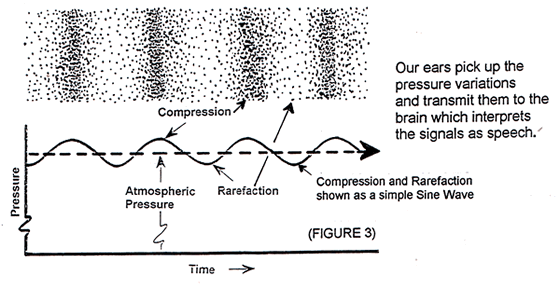
Wavelength and Loudness
The distance between the sound compressions and rarefactions is known as wavelength. Low-frequency sounds have a long wavelength and are perceived as low-pitched sounds such as the rumble of a truck. High-pitched sounds have very short wavelengths such as sound emitted from a whistle. In the field of music, a piano can generate sounds ranging from 20 cycles per second (Hz) all the way up to 4600 cycles per second.
(FIGURE 4) shows several wavelengths in feet and inches as a function of frequency.

Loudness:(Amplitude or Intensity) is measured by the strength of the sound, depicted as a sine wave above and below the normal atmospheric pressure.
(Figure 5) shows the combination of sine waves the sounds at different loudness levels or amplitudes. For the sake of simplicity, the sound intensity or pressure levels are measured in decibels.
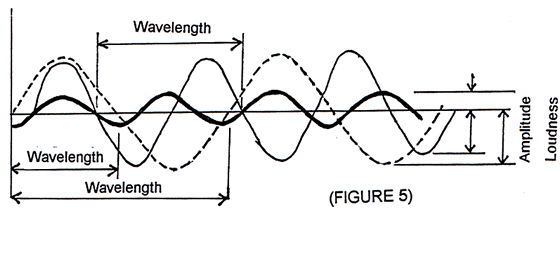
Equal Loudness Contours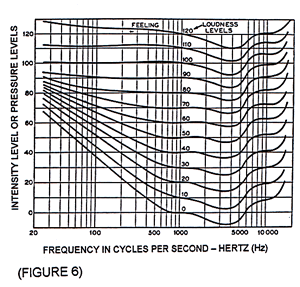
Our ears do not perceive all sounds equally at the various frequencies or sound intensities. (FIGURE 6) shows an equal loudness contour chart. The sound levels for a particular sound as defined by the level at 1000 Hz will find the same for any given frequency along the curve. For example, a 20-decibel sound at 1000 Hz would be perceived as the same sound level of 50 decibels at 100 Hz. This indicates that our ears are less sensitive to low-frequency sounds than mid to high frequencies. As will be seen later, this sensitivity difference will feature repeatedly in the control of noise.
Perception of Sound (Loudness)
The deviation of sound above and below the atmospheric pressure levels is called Sound Pressure. The energy expanded in the process of sound propagation is labeled intensity (loudness) and is measured in energy units. At this point the science of sound can be a little more complex and intimidating since placing a numerical value on sound is very difficult due to the extraordinary sensitivity of the human ear. Our ears can detect deviations in atmospheric pressure in the order of 1,000,000 to 1 and sound intensities of over a trillion to one.
In order to make the measurement, calculation, and perception of sound more manageable, a compact scale has been devised incorporating the decibel (dB). A decibel is a logarithmic unit measure of sound pressure.
(FIGURE 7) Shows sound levels of recognizable sound in decibels with a subjective evaluation from “very faint” to “deafening”. It shows the logarithmic values of intensity of energy units and the relative loudness as perceived by the human ear. Obviously, it is much easier to comprehend the decibel levels.
The Relative Loudness levels are important insofar as they demonstrate that a 10-decibel increase will be perceived as twice as loud as the previous level or conversely, a decrease of 50% from the previous higher level. It is less important to understand the physics of this relative difference as much as to accept it as an acoustical phenomenon.
Note: (FIGURE 7) expresses the sound pressure levels as single number levels in the A weighted scale. The A weighted scale uses the equal loudness contours to provide a single number value in the same manner as our ears perceived sound. The A weighting discounts the low-frequency sound level perception.
Inverse Square Law
Another very important but little known acoustical phenomena is the Inverse Square Law. As a sound wave propagates spherically, the sound energy is distributed over the ever-increasing surface diameter of the wave front surface. The Inverse Square Law teaches us that for every doubling of the distance from the sound source in a free field situation, the sound intensity will diminish by 6 decibels.
Under ideal conditions, a free field could be represented by a sound signal being generated from a mountain peak. In real life situations, however, rooms bounded by walls, floors, and ceilings will interrupt the inverse square law at a distance in an average 30′ square room at approximately 10-12 feet from the sound source. Nevertheless, it is important to accept the notion that sound will diminish in intensity with distance. For example, in a typical classroom with a teachers voice signal of 65 decibels at a three-foot distance from the teacher; at 6 feet away the sound intensity will be 59 decibels and at twelve feet it will diminish down to 53 decibels. (This is important to remember as we discuss the Signal to Noise Ratio S/NR later on)
(FIGURE 8) shows a segment of the sound wave front surface area increasing with distance.
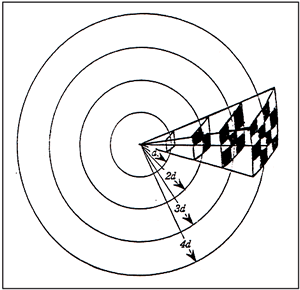
Figure 8 - Angle
In the angle shown in Figure 8, the same sound energy is distributed over the spherical surfaces of increasing areas as d is increased. The intensity of the sound is inversely proportional to the square of the distance of the wavefront from the signal source.
Example:
1d = 1
2d = 4
3d = 9
4d = 16
Sound Absorption
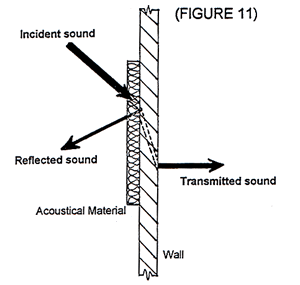
All building materials have some acoustical properties in that they will all absorb, reflect or transmit sound striking them. Conventionally speaking, acoustical materials are those materials designed and used for the purpose of absorbing sound that might otherwise be reflected.
Sound absorption is defined, as the incident sound that strikes a material that is not reflected back. An open window is an excellent absorber since the sounds passing through the open window are not reflected back but makes a poor sound barrier. Painted concrete block is a good sound barrier but will reflect about 97% of the incident sound striking it.
When a sound wave strikes an acoustical material the sound wave causes the fibers or particle makeup of the absorbing material to vibrate. This vibration causes tiny amounts of heat due to the friction and thus sound absorption is accomplished by way of energy to heat conversion. The more fibrous a material is the better the absorption; conversely denser materials are less absorptive. The sound absorbing characteristics of acoustical materials vary significantly with frequency. In general, low-frequency sounds are very difficult to absorb because of their long wavelength. On the other hand, we are less susceptible to low-frequency sounds, which can be to our benefit in many cases.
For the vast majority of conventional acoustical materials, the material thickness has the greatest impact on the material’s sound absorbing qualities. While the inherent composition of the acoustical material determines the material’s acoustical performance, other factors can be brought to bear to improve or influence the acoustical performance. Incorporating an air space behind an acoustical ceiling or wall panel often serves to improve low-frequency performance.
Speech Intelligibility
Speech Intelligibility is defined as the percentage of speech heard correctly by the listener. The emphasis is on “correctly” rather than simply “heard.” Speech intelligibility is influenced by reverberation time, the distance of the listener from the speaker, and background noise level.
Of these elements, reverberation time, and background noise are influenced by the architecture of the space which, suggests that the acoustical environment should be the focus of greater design attention.
Signal To Noise Ratio (S/NR)
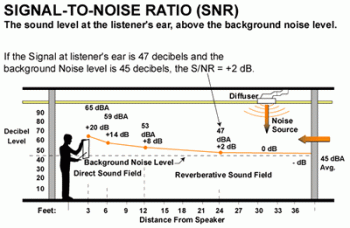
Figure 12 depicts a classroom setting in which the instructor’s voice signal is determined to be approximately 65 dBA at a distance of 3 feet from the teacher. The background noise level is 45 dBA and assumed to be fairly constant through out the room. The Inverse Square Law teaches us that the sound level of the instructor’s voice signal will be 59 dBA at a 6-foot distance, 53 dBA at a 12-foot distance and 47 dBA at a 24-foot distance.
A good Signal to Noise Ratio should be not less than +15 dB, that is to say, the signal strength should be at least 15 decibels above the background noise level in order to achieve good Speech Intelligibility by the listener. From (Figure 12) it can be seen that beyond a 12-foot distance from the instructor the S/NR is far below what it should be.
In a typical classroom, the ambient or background noise level in the unoccupied classroom should not exceed 35 dBA with the HVAC system running.
Ambient Sound Level or Background Noise
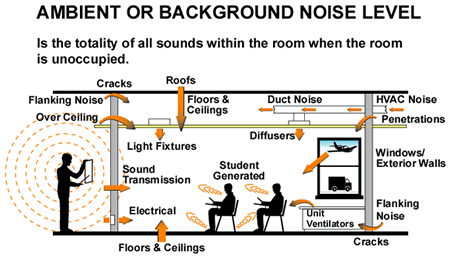
In an unoccupied space, sounds can be heard from a variety of sources. Careful scrutiny of the room can lead to identifying the intrusive sources. The diagram illustrates a few of the most common sources of noise.
Effects of Sound Leak on Partition Sound Insulation
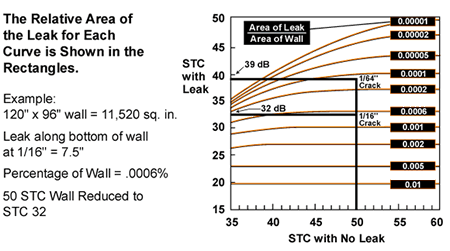
From the gap we can see that even a small crack can significantly compromise the sound isolation performance of a wall, floor /ceiling assembly to be as airtight as possible. Caulking compounds or acoustical sealants are indispensable for effective noise control.
Adding Decibels
When the direct sound diminishes in intensity in accordance with the inverse law the multitude of reflective sound intensities are combining to produce as an increase in the reflected sound levels to a point where the reflected sound can be higher than the direct sound. A typical example of this phenomena would be a voluminous, hard surfaced gymnasium that can experience a significant build up of reflective sound intensity.
Where the direct sound and reflected sound are about equal is called the critical distance. In a typical classroom, critical distance is about 12″ from the source. Beyond the critical distance, the sound reduction will be less than 6 dB.
Sound Absorption Coefficients
Speed of sound
What is Noise?
Simply stated, noise is unwanted sound. An intrusive sound that interferes with speech intelligibility or speech privacy is characterized as noise. Noise is a relative term and can range from low levels of intrusive sound in a quiet environment to very loud sounds in an already noisy environment.
Noise Reduction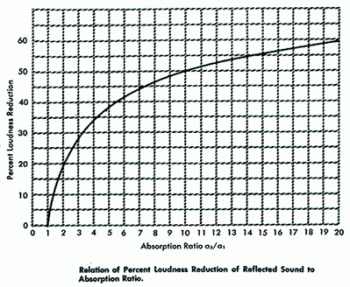
Reflected sounds that are not absorbed will cause an increase in overall sound levels in a space. When the space is acoustically treated, the sound build up is eliminated or reduced. The sound level difference between the untreated space and the acoustically treated space is described as the Noise Reduction (NR).
Sound measured on one side of a wall and then on the opposite side will reflect the sound transmission blocking characteristics of the wall. The difference between the two measurements is described as the Noise Reduction characteristics of the wall.
Treating a noisy reverberant space with acoustical materials can reduce the reflected sound build up that occurs due to the reflective hard surfaces.
In a “before treatment” and “after treatment” comparison the decibel level can be calculated. This diagram can be used to compare how the sound reduction will be perceived.
Example: An existing room with 500 sabines of absorption prior to acoustical treatment that adds an additional 1500 sabins will have an absorption ratio of treated/untreated = 4
The treated room will be perceived to be about 37% quieter than the untreated room.
Noise Interference with Speech Communications
When background or ambient noise levels are sufficiently high enough, the background noise can mask the sound levels of speech that wish to be heard. Restaurants can often be classic examples of excessive noise interference due to lack of sufficient quality or quantity of sound absorbing materials that prevent excessive noise buildup. Diners have to speak louder and louder to be heard and in doing so compete with one another, thereby increasing the sound levels to even greater levels. Appropriate acoustical treatment will prevent the reflected noise build up and significantly reduce the necessity for diners to speak louder to enjoy conversations with one another.
Speech Directivity – Speaker and Listener Orientation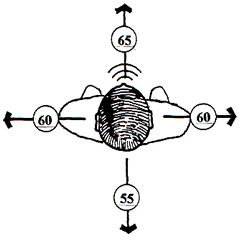
Speaker orientation can be an important factor in classrooms and meeting rooms in particular. As indicated in the diagram, there is a difference of about 10 decibels (dBA) in speech levels between the front and back of the speaker. This amounts to about 1-1/2 decibels per 30 degrees of rotation from the head on direction of the speech signal.
The average sound level of a male speaker is about 65-64 decibels at a distance of 3 feet from the speaker. The average speech level of a female speaker is about 2-4 decibels lower at a 3-foot distance from the speaker.
The orientation of the speaker to the listener is an important consideration. This is particularly so when considered in the context of the Inverse Square Law, which teaches us, that for every doubling of the distance the signal will diminish in intensity by approximately 6 decibels.
Speech Privacy
Speech privacy in an “open office” for example is the ability to maintain the confidentiality of conversational speech from the source to adjacent areas. In the open plan office, speech privacy is accomplished by introducing masking sound by way of white noise, or background music to prevent other employees nearby from understanding what the speaker is saying.
Masking Sound Systems
Most commonly used and necessary in the open plan office layout, sound masking systems involve the generation of the generation of random noise fed through speakers uniformly distributed though out the office to produce a subtle and uniform masking sound level. Sound masking systems provide the means to maintain speech confidentiality as well as a masking protection against other intrusive and distracting noises in the office environment.
Transmission of Sound
Contrary to the popular notion that sound passes through a structure, such is not the case. The sound generated on one side of a wall will energize the wall structure and set it in motion, much like a diaphragm. The wall itself becomes the transmitter of the sound energy which can be heard on the opposite side of the wall by the listener
Resonant Frequencies
When sound waves strike a wall assembly for example, the sound is comprised of a wide spectrum of frequencies. The wall may react to the various frequency energy in different degrees, based on the characteristics and component make up of the wall.
The accompanying diagram depicts 2 walls, one an 8″ concrete block wall and the other a steel stud and gypsum board wall. Each has the same single STC value of 47 but they each have different sound isolation characteristics.
The drywall stud wall does not perform as well at the low frequencies compared to the block wall. While the block wall does not provide as high isolation at the mid range frequencies it maintains a fairly uniform increase in performance across the entire frequency spectrum. Note the drop in performance of the drywall partition between 2000 Hz and 4000 Hz. This drop is known as the “coincidence dip” which reflects the resonant frequency of the wall assembly.
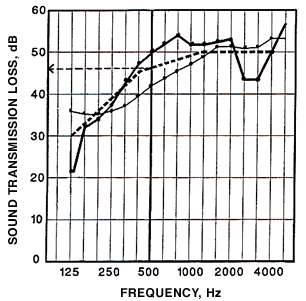
Rather than rely on a single number STC rating, it can often be useful and more effective to look at the total performance data and select a wall, floor or ceiling assembly that will provide the most effective performance based on the anticipated sound generated through the structure. Different structures or construction assemblies have different resonant frequencies.
Check out our Acoustics 101 section for more information or even our Soundproofing Tips if you’re encountering any soundproofing problems.
Sound Transmission Class (STC)
The Sound Transmission Class is a single number rating of the effectiveness of a material or construction assembly to retard the transmission of airborne sound. The sound transmission loss between the source and receiving rooms are plotted on a graph by frequency and sound level in decibels. The STC curve is a sliding contour that is fitted to the performance data plotted in a manner that will allow no more than 32 deficiencies below the appropriate contour. The maximum deficiency at any given frequency shall not exceed 8 decibels.
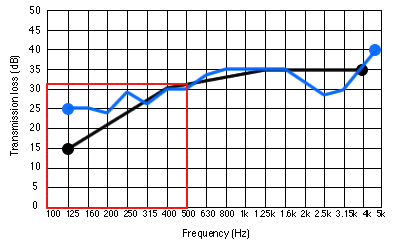
Once the appropriate contour has been selected the STC is determined by the decibel value of the vertical scale at 500 Hz. The STC is expressed as a single STC number (Example STC 32)
Note that the STC contour is similar to the inverse of the equal loudness contour, insofar as it discounts the lower frequency sounds to reflect how our ears perceive the lower frequency sounds.
Sound Isolation
Airborne Sound can be isolated by containing the sound from intruding beyond the source area by blocking it’s potential transmission. Sound isolation can be accomplished by creating appropriate barriers and reducing the reflected sounds in the source area by acoustical absorption within the source area.
Sound Diffusion and Absorption
Sound diffusion is the method of spreading out sound energy with a diffusor (diffuser) for better sound in a space. However, in the wide, wide world of acoustics, the sound diffusion process and tools are widely misunderstood, even by some acoustics professionals. This seems a bit odd, because it’s one of only two tools in our “Better Sounding Room” toolbox.
That’s right – there are only two acoustical tools available to improve sound inside a room, whether that room is huge or tiny: sound absorption and sound diffusion. Both tools will improve sound perception in spaces that, if left untreated, would be a bad influence on sound. In large acoustically-designed spaces, like concert halls, diffusion is most often built into the room’s physical geometry – the shapes of walls and ceilings (floors are nearly always flat and act as large flat-surface reflectors, even if sloped).
Keep in mind that absorption and diffusion are NOT the same as the methods used to reduce sound leakage into and out of a room, usually called “soundproofing,” which results in “less noise” (noise defined as any unwanted sound). Absorption and diffusion are called room treatments and are used for “better sound”.
https://www.acousticalsurfaces.com/acoustic_IOI/101home.htm